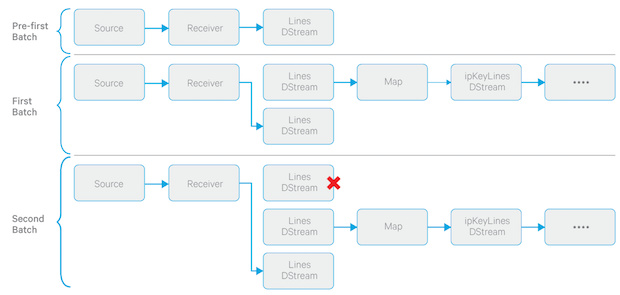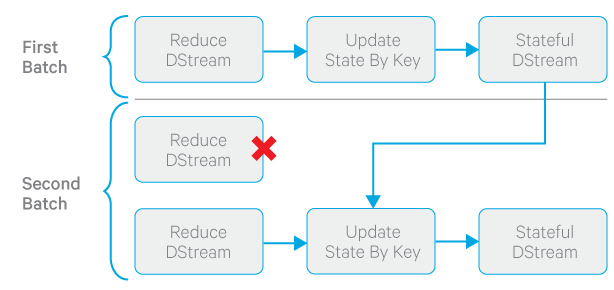怎样利用Spark Streaming和Hadoop实现近实时的会话连接
来源:互联网 发布:手机恢复照片软件 编辑:程序博客网 时间:2024/05/27 00:40
怎样利用Spark Streaming和Hadoop实现近实时的会话连接
13
主题40
帖子966
积分实习版主



about云|新出视频,openstack零基础入门,解决你ping不通外网难题
问题导读
1、怎么设置Spark Streaming?
2、如何实现字符串解析?
3、怎样产生sessions?

这个 Spark Streaming 样例是怎样将近实时会话带到到Hadoop中的一个很好的例子。
Spark Streaming 是Apache Spark 中最有趣的组件之一。利用Spark Streaming,你可以通过使用与处理批量加载数据相同的API来创建数据管道,并通过数据管道处理流式数据。此外,Spark Steaming的“micro-batching”方式提供相当好的弹性来应对某些原因造成的任务失败。
在这篇文章中,我将通过演示网站事件的近实时会话使你熟悉一些常用的以及高级的Spark Streaming功能,然后在Apache HBase中加载事件的有关统计数据,最后选择你喜欢的BI工具进行绘图分析。 (Sessionization指的是捕获单一访问者的网站会话时间范围内所有的点击流事件。)你可以在这里找到了演示的代码。
像这样的系统对于了解访问者的行为(不管是人还是机器)是超级有用的。通过一些额外的工作,它也可以被设计用来包含windowing模式,以此来用异步的方式发现可能的欺骗。
Spark Streaming 代码
我们例子中的main class是:
让我们来看看这段代码段(忽略1-59行,它包含了imports 和其他无聊的东西)。
60到112行:设置Spark Streaming
这些代码是Spark Streaming最基本的开始,并可以选择从HDFS或socket接收数据流。如果你是Spark Streaming新手,我已经添加了一些详细的注释帮助理解代码。 (我不打算在这里详谈,因为此时我们仍要讨论代码。)
114到124行: 字符串解析
这里是Spark Streaming开始的地方. 请看一下几行::
上面第一行代码是对“lines” DStream对象做了一个map函数,并解析原始事件分离出IP地址,时间戳和事件体。对于那些新进入Spark Streaming的人而言,一个DSTREAM保存着要处理的一批记录。这些记录由以前所定义的receiver对象填充,并且此map函数在这个micro-batch内产生另一个DSTREAM存储变换后的记录来进行额外的处理。

当看像上面的Spark Streaming示意图时,有一些事情要注意:
每个micro-batch在你构造StreamingContext时设定的那一秒时会被销毁
Receiver总是被下一个micro-batch中的即将到来的RDDS填充
之前micro batch中旧的RDDs将被清理丢弃
126到135行:产生Sessions
现在,我们有从网络日志中获得的IP地址和时间,是时候建立sessions了。下面的代码是通过micro-batch内的第一聚集事件建立session,然后在有状态的DStream中减少这些会话的块。
这里有一个关于records如何在micro-batch中被reduce的例子:

会话范围内的 micro-batch 内加入,我们可以用超酷的updateStateByKey功能,它可以利用先前活跃的micro-batch中的一个DStream做join/reduce-like操作。下图详细说明了,就DStreams而言,随着时间变化这个处理过程是怎样的。

现在,让我们深入到定义在文件的底部的updateStatbyOfSessions函数。该代码(注意详细注释)很神奇,能使会话流程以连续的微批处理模式发生。
这段代码通过很多方式做了很多事,这是整个工作中最复杂的部分。总之,它会跟踪活动的会话,所以你会知道你是继续现有的会话还是启动一个新的。
126到207行:计数和HBase
这部分做了大量的计数工作。在这里有很多是重复的,所以让我们只看一个count的例子,然后我们再一步步地把在相同记录中产生的counts存储在HBase中。
总之,上面的代码是过滤了除活动会话之外的其他所有会话,对他们进行计数,并把最终的计数记录存储到一个的HashMap实例中。它使用HashMap作为容器,所以在所有的count做完后,我们可以调用下面的reduce函数把他们都合并为一个单独的记录。 (我敢肯定还有更好的方法来实现这一点,但这种方法也做的不错。)
接下来,下面的代码处理所有的HashMap,并把他们所有的值存储在在一个HashMap中。
Spark Streaming与HBase利用HBaseContext进行交互非常简单。所有你需要做的就是用HashMap和函数将其转换为一个put对象提供给DSTREAM。
现在,HBase的这些信息可以用Apache Hive table打包,然后通过你喜欢的BI工具执行一个查询来获取像下面这样的图,每一次micro-batch该图都将刷新。

209到215行:写入HDFS
最后的任务是把事件数据加入到活动的会话信息中,然后把事件以会话的开始时间保存到HDFS。
结论
我希望你跳出这个例子,能感受到只用少量的代码就完成了大量的工作,因为它就是这样的。想象一下你还可以用这种模式和Spark Streaming与HBase HDFS很容易交互的能力去做什么东西。
Ted Malaska 是 Cloudera 的一个解决方案架构师,Apache Spark的一个贡献者,O’Reilly的书 Hadoop Applications Architecture 的合著者。
1、怎么设置Spark Streaming?
2、如何实现字符串解析?
3、怎样产生sessions?
这个 Spark Streaming 样例是怎样将近实时会话带到到Hadoop中的一个很好的例子。
Spark Streaming 是Apache Spark 中最有趣的组件之一。利用Spark Streaming,你可以通过使用与处理批量加载数据相同的API来创建数据管道,并通过数据管道处理流式数据。此外,Spark Steaming的“micro-batching”方式提供相当好的弹性来应对某些原因造成的任务失败。
在这篇文章中,我将通过演示网站事件的近实时会话使你熟悉一些常用的以及高级的Spark Streaming功能,然后在Apache HBase中加载事件的有关统计数据,最后选择你喜欢的BI工具进行绘图分析。 (Sessionization指的是捕获单一访问者的网站会话时间范围内所有的点击流事件。)你可以在这里找到了演示的代码。
像这样的系统对于了解访问者的行为(不管是人还是机器)是超级有用的。通过一些额外的工作,它也可以被设计用来包含windowing模式,以此来用异步的方式发现可能的欺骗。
Spark Streaming 代码
我们例子中的main class是:
让我们来看看这段代码段(忽略1-59行,它包含了imports 和其他无聊的东西)。
60到112行:设置Spark Streaming
这些代码是Spark Streaming最基本的开始,并可以选择从HDFS或socket接收数据流。如果你是Spark Streaming新手,我已经添加了一些详细的注释帮助理解代码。 (我不打算在这里详谈,因为此时我们仍要讨论代码。)
[Java] 纯文本查看 复制代码
01
02
03
04
05
06
07
08
09
10
11
12
13
14
15
16
17
18
19
20
21
22
23
24
25
26
27
28
29
30
31
32
33
34
35
36
37
38
39
40
41
42
43
44
45
46
47
48
49
50
51
52
53
54
55
56
57
58
59
60
61
62
63
64
65
66
67
68
69
70
71
72
73
//This is just creating a Spark Config object. I don't do much here but //add the app name. There are tons of options to put into the Spark config, //but none are needed for this simple example. val sparkConf = newSparkConf(). setAppName("SessionizeData " + args(0)). set("spark.cleaner.ttl","120000") //These two lines will get us out SparkContext and our StreamingContext. //These objects have all the root functionality we need to get started. val sc = newSparkContext(sparkConf) val ssc = newStreamingContext(sc, Seconds(10)) //Here are are loading our HBase Configuration object. This will have //all the information needed to connect to our HBase cluster. //There is nothing different here from when you normally interact with HBase. val conf = HBaseConfiguration.create(); conf.addResource(newPath("/etc/hbase/conf/core-site.xml")); conf.addResource(newPath("/etc/hbase/conf/hbase-site.xml")); //This is a HBaseContext object. This is a nice abstraction that will hide //any complex HBase stuff from us so we can focus on our business case //HBaseContext is from the SparkOnHBase project which can be found at // [url]https://github.com/tmalaska/SparkOnHBase[/url] val hbaseContext = newHBaseContext(sc, conf); //This is create a reference to our root DStream. DStreams are like RDDs but //with the context of being in micro batch world. I set this to null now //because I later give the option of populating this data from HDFS or from //a socket. There is no reason this could not also be populated by Kafka, //Flume, MQ system, or anything else. I just focused on these because //there are the easiest to set up. var lines: DStream[String] = null //Options for data load. Will be adding Kafka and Flume at some point if(args(0).equals("socket")) { val host = args(FIXED_ARGS); val port = args(FIXED_ARGS + 1); println("host:"+ host) println("port:"+ Integer.parseInt(port)) //Simple example of how you set up a receiver from a Socket Stream lines = ssc.socketTextStream(host, port.toInt) }elseif (args(0).equals("newFile")) { val directory = args(FIXED_ARGS) println("directory:"+ directory) //Simple example of how you set up a receiver from a HDFS folder lines = ssc.fileStream[LongWritable, Text, TextInputFormat](directory, (t: Path) => true,true).map(_._2.toString) }else{ thrownew RuntimeException("bad input type") }114到124行: 字符串解析
这里是Spark Streaming开始的地方. 请看一下几行::
[Java] 纯文本查看 复制代码
01
02
03
04
05
06
07
08
09
10
11
12
13
14
val ipKeyLines = lines.map[(String, (Long, Long, String))](eventRecord => { //Get the time and ip address out of the original event val time = dateFormat.parse( eventRecord.substring(eventRecord.indexOf('[') + 1, eventRecord.indexOf(']'))). getTime() val ipAddress = eventRecord.substring(0, eventRecord.indexOf(' ')) //We are return the time twice because we will use the first at the start time //and the second as the end time (ipAddress, (time, time, eventRecord)) })上面第一行代码是对“lines” DStream对象做了一个map函数,并解析原始事件分离出IP地址,时间戳和事件体。对于那些新进入Spark Streaming的人而言,一个DSTREAM保存着要处理的一批记录。这些记录由以前所定义的receiver对象填充,并且此map函数在这个micro-batch内产生另一个DSTREAM存储变换后的记录来进行额外的处理。

当看像上面的Spark Streaming示意图时,有一些事情要注意:
每个micro-batch在你构造StreamingContext时设定的那一秒时会被销毁
Receiver总是被下一个micro-batch中的即将到来的RDDS填充
之前micro batch中旧的RDDs将被清理丢弃
126到135行:产生Sessions
现在,我们有从网络日志中获得的IP地址和时间,是时候建立sessions了。下面的代码是通过micro-batch内的第一聚集事件建立session,然后在有状态的DStream中减少这些会话的块。
[Java] 纯文本查看 复制代码
01
02
03
04
05
06
07
08
09
10
11
12
val latestSessionInfo = ipKeyLines. map[(String, (Long, Long, Long))](a => { //transform to (ipAddress, (time, time, counter)) (a._1, (a._2._1, a._2._2, 1)) }). reduceByKey((a, b) => { //transform to (ipAddress, (lowestStartTime, MaxFinishTime, sumOfCounter)) (Math.min(a._1, b._1), Math.max(a._2, b._2), a._3 + b._3) }). updateStateByKey(updateStatbyOfSessions)这里有一个关于records如何在micro-batch中被reduce的例子:

会话范围内的 micro-batch 内加入,我们可以用超酷的updateStateByKey功能,它可以利用先前活跃的micro-batch中的一个DStream做join/reduce-like操作。下图详细说明了,就DStreams而言,随着时间变化这个处理过程是怎样的。

现在,让我们深入到定义在文件的底部的updateStatbyOfSessions函数。该代码(注意详细注释)很神奇,能使会话流程以连续的微批处理模式发生。
[Java] 纯文本查看 复制代码
001
002
003
004
005
006
007
008
009
010
011
012
013
014
015
016
017
018
019
020
021
022
023
024
025
026
027
028
029
030
031
032
033
034
035
036
037
038
039
040
041
042
043
044
045
046
047
048
049
050
051
052
053
054
055
056
057
058
059
060
061
062
063
064
065
066
067
068
069
070
071
072
073
074
075
076
077
078
079
080
081
082
083
084
085
086
087
088
089
090
091
092
093
094
095
096
097
098
099
100
101
102
/** * This function will be called for to union of keys in the Reduce DStream * with the active sessions from the last micro batch with the ipAddress * being the key * * To goal is that this produces a stateful RDD that has all the active * sessions. So we add new sessions and remove sessions that have timed * out and extend sessions that are still going */ def updateStatbyOfSessions( //(sessionStartTime, sessionFinishTime, countOfEvents) a: Seq[(Long, Long, Long)], //(sessionStartTime, sessionFinishTime, countOfEvents, isNewSession) b: Option[(Long, Long, Long, Boolean)] ): Option[(Long, Long, Long, Boolean)] = { //This function will return a Optional value. //If we want to delete the value we can return a optional "None". //This value contains four parts //(startTime, endTime, countOfEvents, isNewSession) var result: Option[(Long, Long, Long, Boolean)] = null // These if statements are saying if we didn't get a new event for //this session's ip address for longer then the session //timeout + the batch time then it is safe to remove this key value //from the future Stateful DStream if(a.size == 0) { if(System.currentTimeMillis() - b.get._2 > SESSION_TIMEOUT + 11000) { result = None }else{ if(b.get._4 == true) { result = b }else{ result = Some((b.get._1, b.get._2, b.get._3, true)) } } } //Now because we used the reduce function before this function we are //only ever going to get at most one event in the Sequence. a.foreach(c => { if(b.isEmpty) { //If there was no value in the Stateful DStream then just add it //new, with a true for being a new session result = Some((c._1, c._2, c._3, true)) }else{ if(c._1 - b.get._2 < SESSION_TIMEOUT) { //If the session from the stateful DStream has not timed out //then extend the session result = Some(( Math.min(c._1, b.get._1), //newStartTime Math.max(c._2, b.get._2), //newFinishTime b.get._3 + c._3, //newSumOfEvents true//This is not a new session )) }else{ //Otherwise remove the old session with a new one result = Some(( c._1,//newStartTime c._2,//newFinishTime b.get._3,//newSumOfEvents true//new session )) } } }) result }}这段代码通过很多方式做了很多事,这是整个工作中最复杂的部分。总之,它会跟踪活动的会话,所以你会知道你是继续现有的会话还是启动一个新的。
126到207行:计数和HBase
这部分做了大量的计数工作。在这里有很多是重复的,所以让我们只看一个count的例子,然后我们再一步步地把在相同记录中产生的counts存储在HBase中。
[Java] 纯文本查看 复制代码
01
02
03
04
05
06
07
08
09
10
11
val onlyActiveSessions = latestSessionInfo.filter(t => System.currentTimeMillis() - t._2._2 < SESSION_TIMEOUT)…val newSessionCount = onlyActiveSessions.filter(t => { //is the session newer then that last micro batch //and is the boolean saying this is a new session true (System.currentTimeMillis() - t._2._2 > 11000&& t._2._4) }). count. map[HashMap[String, Long]](t => HashMap((NEW_SESSION_COUNTS, t)))总之,上面的代码是过滤了除活动会话之外的其他所有会话,对他们进行计数,并把最终的计数记录存储到一个的HashMap实例中。它使用HashMap作为容器,所以在所有的count做完后,我们可以调用下面的reduce函数把他们都合并为一个单独的记录。 (我敢肯定还有更好的方法来实现这一点,但这种方法也做的不错。)
接下来,下面的代码处理所有的HashMap,并把他们所有的值存储在在一个HashMap中。
[Java] 纯文本查看 复制代码
1
2
3
4
5
6
7
val allCounts = newSessionCount. union(totalSessionCount). union(totals). union(totalEventsCount). union(deadSessionsCount). union(totalSessionEventCount). reduce((a, b) => b ++ a)Spark Streaming与HBase利用HBaseContext进行交互非常简单。所有你需要做的就是用HashMap和函数将其转换为一个put对象提供给DSTREAM。
[Java] 纯文本查看 复制代码
01
02
03
04
05
06
07
08
09
10
11
12
13
14
15
16
17
18
19
hbaseContext.streamBulkPut[HashMap[String, Long]]( allCounts,//The input RDD hTableName,//The name of the table we want to put too (t) => { //Here we are converting our input record into a put //The rowKey is C for Count and a backward counting time so the newest //count show up first in HBase's sorted order val put = newPut(Bytes.toBytes("C."+ (Long.MaxValue - System.currentTimeMillis()))) //We are iterating through the HashMap to make all the columns with their counts t.foreach(kv => put.add(Bytes.toBytes(hFamily), Bytes.toBytes(kv._1), Bytes.toBytes(kv._2.toString))) put }, true)现在,HBase的这些信息可以用Apache Hive table打包,然后通过你喜欢的BI工具执行一个查询来获取像下面这样的图,每一次micro-batch该图都将刷新。

209到215行:写入HDFS
最后的任务是把事件数据加入到活动的会话信息中,然后把事件以会话的开始时间保存到HDFS。
[Java] 纯文本查看 复制代码
1
2
3
4
5
6
7
8
//Persist to HDFSipKeyLines.join(onlyActiveSessions). map(t => { //Session root start time | Event message dateFormat.format(newDate(t._2._2._1)) + "t"+ t._2._1._3 }). saveAsTextFiles(outputDir + "/session","txt")结论
我希望你跳出这个例子,能感受到只用少量的代码就完成了大量的工作,因为它就是这样的。想象一下你还可以用这种模式和Spark Streaming与HBase HDFS很容易交互的能力去做什么东西。
Ted Malaska 是 Cloudera 的一个解决方案架构师,Apache Spark的一个贡献者,O’Reilly的书 Hadoop Applications Architecture 的合著者。
0 0
- 怎样利用Spark Streaming和Hadoop实现近实时的会话连接
- 怎样利用Spark Streaming和Hadoop实现近实时的会话连接
- 利用Spark Streaming来实现实时的数据管道服务
- 用Spark Streaming+Kafka实现订单数和GMV的实时更新
- Spark Streaming+kafka订单实时统计实现
- 用spark streaming实现黑名单实时过滤
- Spark-Streaming 和Kafka连接的两种方式
- Spark-Streaming 和Kafka连接的两种方式
- spark-streaming系列------- 5. Spark-Streaming checkpoint的原理和实现
- Spark Streaming实现实时WordCount,DStream的使用,updateStateByKey(func)实现累计计算单词出现频率
- lucene4之后的近实时搜索实现
- 实时流Streaming大数据:Storm,Spark和Samza
- 使用 Kafka 和 Spark Streaming 构建实时数据处理系统
- 实时流Streaming大数据:Storm,Spark和Samza
- 使用 Kafka 和 Spark Streaming 构建实时数据处理系统
- 使用 Kafka 和 Spark Streaming 构建实时数据处理系统
- Spark Streaming实时读取Kafka
- spark streaming 实时统计mysql
- bindService用法
- php中利用header设置content-type和常见文件类型的content-type
- MIT评选出的全球最聪明的50个公司-完整名单(附带往年名单)!
- 使用析构函数防止资源泄漏
- 大数据架构和模式(五):利用大数据识别保险行业中的欺诈业务案例
- 怎样利用Spark Streaming和Hadoop实现近实时的会话连接
- 安卓网络编程——webView加载有道网页
- Hadoop的集群数据、mapreduce管理及安全机制介绍
- 关于“ORA-01653: unable to extend table SYS.AUD$ by 128 in tablespace SYSTEM”的错误
- RNN的历史(from Deep Learning RNNaissance with Dr. Juergen Schmidhuber)
- 转 错误代码2104:无法下载Silverlight应用程序。请查看Web服务器设置
- java4Android(15)字节流大文件读写,字符流读写
- 用map, next 和 reject 简化代码(ruby)
- Effective C++ 条款10





